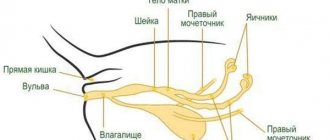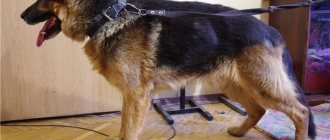When a dog's hind legs fail, this is a serious reason to urgently contact a veterinarian. The sooner you can help your pet, the greater the chance that the animal will be able to walk again. Having established the cause, the doctor will select treatment, which in most cases is strictly individual and may include not only the use of medications, but also physical therapy.
It should be distinguished when a dog’s mobility decreases due to internal diseases, while the pet experiences weakness and pain. Pathologies from the musculoskeletal system and neurology require special attention and longer recovery.
Reasons why a dog's paws fail
The reasons why a dog loses its hind legs can be directly related to disorders in the pelvic limbs. It is more serious if the problem occurs in the spine area. As a rule, correcting such pathologies is much more difficult and not always possible.
► Separately, we can consider the problem when a dog loses its paw after an injection. This situation occurs when a drug is prescribed intramuscularly, the administration of which causes acute painful sensations. Also, the mobility of the limb is impaired if the injection is made in the area where the nerve endings pass. There is no need to take any measures; the pet’s condition is monitored. Usually, everything returns to normal within a few days. The remaining injections are given to the other paw.
Below we describe the main situations in which diseases a dog’s hind legs fail.
Injuries
The injuries involve a fracture, sprain, or damage to the tendons of the limb or spinal column. Most often occur when:
- Road traffic accident. Due to the high force during the impact, the pet suffers severe pathologies of the spine, pelvic limbs and internal organs.
- The use of physical force by a person (especially in the lumbar and sacral regions).
- Bites received in a fight with other animals of the same or greater weight and size.
- Falling or jumping with an unsuccessful landing from a great height.
Discopathy
Intervertebral disc pathologies are a common cause that disrupts the functioning of the pelvic limbs. These are connective tissue layers between the vertebrae. They act as shock absorbers and participate in the mobility of the spinal column.
With discopathy, altered disc substance penetrates into the spinal canal. The result is pinching of the spinal cord or spinal nerve roots. A deficiency of nerve conduction to the pelvic limbs develops, and in advanced cases, to vital internal organs.
Dysplasia
This is an abnormal development of the hip joint. The pathology appears with age when the joint develops improperly due to increased mobility (including frequent walking on stairs by a small puppy). This leads to subluxation or dislocation of the joint and injury to the articular surface, causing the load inside to change.
What is important to know:
- Animals with hip dysplasia should be excluded from breeding.
- Immediately after the puppy is born, no abnormalities can be detected.
- Joint mobility decreases gradually; it is important to take timely measures.
- The acute phase of the pathology appears at the age of 5-12 months and becomes chronic in adult dogs.
Osteochondrosis
The most severe damage to the joints. The pathology is associated with a disorder in the area of the cartilaginous zones of the bone. Degenerative processes and focal ossification disorders occur.
The reasons for the development of pathology in dogs have not been precisely identified, but it is believed that heredity, living conditions and feeding are important factors. It can appear at any age, but is more often noted in older animals (aged 8-9 years and older). The disease is also noted in large breed dogs due to increased stress on the joints.
Arthritis and arthrosis
Arthritis is a common form of inflammatory joint disease in dogs. The pathology is characterized by gradual loss of cartilage tissue, exposure of nerve endings, pain, inflammation and decreased mobility.
Arthrosis is a degenerative change that results in premature wear of the intra-articular surface of the cartilage. The cartilage tissue becomes dry, less elastic, and gradually wears off. Movement causes pain to the pet, physical activity is greatly reduced.
Spondylosis
The disease is associated with local age-related changes in some vertebral segments. The ligamentous apparatus ossifies, bone growths appear, which compress adjacent vertebrae, as well as nerve endings. The pet experiences pain and the mobility of the pelvic limbs gradually decreases.
The development of pathology is characterized by a slow course and is almost impossible to recognize at an early stage. An important factor in the occurrence of pathology is genetic predisposition.
Tumors in the spine
Tumors developing in the spine or its immediate vicinity lead to a number of pathological changes and sometimes even a fracture of the spinal column. As the tumor grows, it causes swelling of the tissue, which leads to compression of the nerves or spinal cord.
One of the most common and dangerous tumors of the bone apparatus is osteosarcoma. This is always a malignant neoplasm, characterized by excessive atypical growth of bone tissue and lysis of the bone itself.
Viral and infectious diseases
The most dangerous viral disease in which the mobility of the pelvic limbs is impaired is a form of canine distemper, which affects the central nervous system. The dog gradually loses its hind legs, it shakes, coordination of movements is impaired, and the pet’s behavior changes. The changes occurring in the brain are irreversible.
If a dog is bitten by a tick and after some time the pet's hind legs give out, this may indicate infection with borreliosis. The pathogen affects the joints; the animal experiences pain and swelling in problem areas.
Overweight
Restriction of mobility of the pelvic limbs can occur with extreme degrees of obesity. This is due to the fact that the load on all joints increases several times.
In addition to excessive wear and tear on the joints, due to an imbalance in feeding, the animal does not receive important components that are necessary for the restoration and normal functioning of cartilage tissue.
Varieties
Based on the degree of loss of the ability of the paws to move, plegia (paralysis) and paresis are distinguished. With paresis of the hind limbs, the dog can move by dragging its paws. If plegia develops, the paws completely lose mobility.
Paralysis refers to a permanent relaxed state of muscles due to damage to the motor nerves. Based on the level of damage to the nervous system, a distinction is made between central plegia, caused by pathologies of the brain, and peripheral plegia, in which the spinal cord is damaged. With central paralysis there is no muscle atrophy, but with peripheral paralysis the muscles degrade and degenerate.
Based on the type of damage to the nervous system, a distinction is made between functional paralysis, in which there is a chance to restore motor ability, and organic paralysis, when irreversible changes have occurred.
According to the degree of loss of mobility, complete paralysis is distinguished, for example, tetraplegia, in which all 4 limbs are affected, and partial ones.
There are the following types of fragmented loss of mobility:
- monoplegia - one limb does not function;
- paraplegia - paralyzed hind legs or front legs;
- semiplegia - muscles on one side of the body are relaxed;
- damage to the trigeminal nerve - the muscles of the lower jaw do not work.
Accordingly, pathologies in which paresis develops are called monoparesis, paraparesis, hemiparesis, tetraparesis.
Paraplegia.
Neurological paresis occurs as a result of stressful situations and psychological trauma and gradually leads to paralysis of the animal.
Dysplasia is a hereditary disease that develops slowly and is accompanied by tissue degeneration. First there is relaxation, then plegia.
Unpleasant additional symptoms are loss of control over bowel movements and urination.
Signs that your dog's back legs are failing
The problem only rarely occurs suddenly and in most cases it is associated with injury. In an adult dog, the process occurs gradually, so it is important to recognize the first signs that your pet’s hind legs are failing as early as possible. The main signs that may indicate the development of a problem:
- The animal began to shuffle.
- It is difficult for the pet to get up, and it takes a long time to lay down and choose the most painless positions.
- Shows anxiety when touching the back.
- Lameness.
- General activity decreases, the animal is reluctant to participate in games.
- The pet periodically drags its hind legs, and as the process progresses, the limbs may become loose for a couple of minutes.
- The dog takes unnatural poses.
- Change in gait, hind legs do not obey.
- Painful sensations disappear as the process worsens.
- When making sudden movements, the dog yelps.
- The back is unnaturally hunched (often in dachshunds, Pekingese, boxers).
When a dog is injured, the following signs are noted:
- The animal cannot get up, and if it gets up, it is only on its thoracic limbs, dragging its pelvic limbs behind it.
- There is no urination, or, conversely, the process is uncontrolled.
- There is blood in the urine.
- Breathing heavily.
- State of shock.
Breeds that are at risk
The problem can occur in any animal, regardless of size. However, in a number of breeds, due to the characteristics of genetics and exterior, pathology is more common:
- dachshund;
- German Shepherd;
- Labrador;
- basset;
- pug;
- beagle;
- English Cocker Spaniel;
- Shih Tzu;
- French Bulldog;
- Saint Bernard;
- German dog.
Treatment
Treatment is only possible if the paralysis is reversible. Therefore, if you notice that your pet’s paws are giving way, do not delay your visit to the clinic. With timely treatment, the chances of a full recovery increase. Don't be overconfident. You may be able to eliminate the symptoms on your own, but the cause remains and the likelihood of relapse is high.
At the clinic, your dog will be x-rayed and samples will be taken for analysis. Without waiting for the results to be deciphered, symptomatic treatment will be prescribed using the following medications:
- multivitamins;
- immunostimulants;
- analgesics;
- antispasmodics;
- glucocorticosteroids that relieve inflammation.
With paralysis, innervation is disrupted and muscles that do not receive signals from the nervous system atrophy. To prevent this from happening, physiotherapy is prescribed - massage, rubbing, warming. If you love your pet, you will learn to do this.
When a contagious disease is diagnosed, treatment begins. A timely visit to the clinic after an ixodid tick bite will allow you to avoid paralysis altogether or stop the process at the initial stage.
The imagination of dog breeders gives the arthropod the ability to inject poisons that can paralyze the dog. In fact, the danger is posed by babesia - single-celled parasites that settle in red blood cells, causing piroplasmosis. Another name for the disease is babesiosis.
Ixodid ticks on a dog.
Read more: How to remove a tick from a dog?
The veterinarian prescribes the following types of drugs:
- antibabesia - Azidin, Berenil, etc.;
- supporting - hepatoprotectors, immunostimulants, cardiac medications, vitamin preparations;
- electrolytes to ensure optimal salt ratio and prevent dehydration.
For your recovering dog, provide therapeutic nutrition and limit exercise.
Treatment of the nervous form of plague must be entrusted to a specialist. Do not use folk remedies, especially the medicine adored by Russians - vodka. The sooner you start treatment, the greater the chances of a speedy recovery. If the dog survives, 2-3 weeks after the detection of clinical symptoms, nervous phenomena develop - head twitching, tics, corneal lesions, paresis, paralysis of the hind limbs.
In such a situation, stimulants are contraindicated; drugs that suppress the immune system are required. For this purpose, corticosteroids are used to stop the inflammatory process. The dog is transferred to therapeutic nutrition.
To prevent brain swelling, diuretics are given. To restore brain activity, the veterinarian prescribes Cerebrolysin. Symptomatic medications are used if the disease is accompanied by pain or cardiac pathologies.
With hip dysplasia, bone and cartilage tissue are gradually destroyed. The disease is accompanied by pain when moving, lameness, turning into paresis and paralysis. Conservative treatment involves long-term, and in some situations lifelong treatment, with anti-inflammatory, analgesic drugs, as well as drugs that prevent the destruction of bone and connective tissue. In severe and advanced cases, surgery is indicated.
For all options, organize therapeutic nutrition. I recommend using ready-made food containing chondroprotectors, which will be prescribed by a veterinarian. For six months or more, limit movements and provide gentle exercise. If possible, organize swimming treatment, during which the load may not be limited.
For pathologies of an allergic nature, antihistamines are prescribed. To alleviate the pet's suffering, a suprapleural novocaine blockade according to Mosin is performed. In such a situation, the dog requires special care. The dog does not feel pain and may get injured. In some cases, he recommends keeping him in a cage.
When a tumor is diagnosed, it is operated on; in case of fractures, bones are fused. In all cases, treatment is lengthy and recovery may take many months.
Watch the video:
What to do if your dog's paws fail?
When the first signs appear that your dog’s hind legs are failing, you must immediately contact a veterinary clinic to diagnose the cause and receive quality treatment. The following studies are carried out:
- Radiography is the most revealing method.
- Myelography (before taking an image, a contrast agent is injected into the spinal canal).
- MRI.
- Specific orthopedic tests that will help identify the preservation of the sensitivity of reflexes in the pelvic limb.
- General studies: blood tests, urine tests, ultrasound.
Treatment under the supervision of a veterinarian
Treatment is aimed at eliminating the underlying cause that caused the disorder. Conservative therapy is carried out depending on the general condition of the pet, the degree of damage to the pelvic limbs and includes:
- Taking anti-inflammatory and painkillers.
- If the hind legs fail in a pregnant or already whelped dog, this may indicate eclampsia (a sharp decrease in calcium in the blood). The pathology requires immediate treatment, as it can be fatal.
- Symptomatic treatment for concomitant diseases.
- Strict cage keeping is recommended for your pet.
- In situations where a dog’s hind legs suddenly fail, intensive therapy is carried out until the animal’s condition is stabilized and the causes and associated lesions are identified.
Operation
Surgical treatment is preferable in cases where drug treatment and physical therapy do not have positive dynamics. It is carried out for the following pathologies:
- Discopathies. Surgically, the spinal cord is freed from the influence of the disc substance and the pathological area is removed.
- Neoplasms.
- Injuries.
- Dysplasia.
Treatment at home
During treatment, one of the main measures is strict limitation of mobility. The pet is placed in a small, cramped cage with soft bedding. You can communicate with the dog, give toys, but at the same time maintain conditions so that it does not actively move or walk.
To restore mobility, in consultation with a doctor, the following is carried out:
- special exercises aimed at preventing the loss of muscle memory;
- swimming in special complexes;
- muscle massage.
The feed includes supplements containing glucosamine and chondroitin.
Causes
As already noted, many negative factors can cause such serious physiological consequences. Among them, it is worth highlighting the following most common:
| Infectious diseases | If they occur in a severe form, alternatively, it could be canine distemper, which occurs quite often in unvaccinated dogs. |
| Mechanical damage | Or rupture of nerve fibers as a result of accidents or intentional beatings. There are frequent cases of animals getting hit by cars. |
| Inflammatory processes | Although infrequent, they can still cause paralysis of the hind limbs in dogs. |
| Strokes and heart attacks | A very likely factor is loss of sensitivity, at least partially in the paws. |
| Oncology | In all forms of its manifestation. Such a diagnosis is not something to joke about. And here it is important to take the most serious measures. |
| Ticks | Carriers of serious infections have recently posed a threat not only to domestic animals, but also to humans. |
But there is another aggressive and inevitable factor that can lead to paralysis. And there seems to be no way to fight it at all. We are, of course, talking about old age and physical and physiological, and natural, wear and tear of the body.
What should you not do if your dog's paws fail?
When the first problems with your pet’s pelvic limbs appear, the main thing is to consult a doctor as quickly as possible. The use of independent measures is unacceptable, as they can aggravate the course of the pathology.
What not to do if your dog’s hind legs fail:
- Do not use painkillers before visiting the veterinarian. Pain limits mobility, and when pain is reduced, the animal will continue to move in its usual rhythm, which will worsen the condition. In addition, the doctor will not be able to fully assess the extent of the damage.
- Warming or cooling the affected area.
- Increase or leave the same level of load for the pet.
- Use traditional medicine.
Content
1. Types of paralysis of the hind limbs in dogs 2. Causes of occurrence 3. Symptoms 4. Diagnosis of paralysis of the limbs in dogs 5. Treatment process 6. Rehabilitation
Dog lovers have to deal with various ailments from time to time when caring for their pets. But the most problematic and unpleasant, although not life-threatening, is paralysis of the hind limbs in dogs. In the vast majority of cases, people think that the animal is doomed and it is not possible to help it. However, this is not always true.
Pet care
For a dog, limited mobility is stressful. During the treatment and recovery period, it is important to constantly maintain contact with your pet. After consultation with the doctor, the diet is reviewed.
Age-related joint problems in older pets cannot be cured. Therefore, when an old dog’s hind legs fail, the main steps that can be taken to help are to reduce pain and create the most comfortable conditions (soft bedding, assistance when going up and down steps, etc.)
Tremor as a sign of disease
Trembling in dogs
- rapid rhythmic muscle contractions of individual parts of the body (for example, limbs) or the whole body, which the animal cannot control. Scientifically, trembling is called tremor. Tremor cannot be called an independent disease; rather, it is a symptom of some disease. Tremors most often occur in the following cases:
- Electrolyte imbalance.
The dog tucks its tail and trembles as if it were frozen. This happens with electrolyte imbalance, when the ratio of magnesium and potassium in the body is disturbed. The causes of this condition are often poor nutrition, as well as problems with the thyroid gland and kidneys. If there are problems with electrolyte metabolism in dogs, in addition to tremors, the following symptoms are observed: convulsions, a drop in blood pressure, pale mucous membranes, coldness of the extremities, irregular pulses, possible vomiting and a rise in temperature. In the clinic, a dog with this problem is given intravenous water-salt solutions;
Poisoning.
When a dog does not eat and is trembling, it can be assumed that it has been poisoned. Moreover, poisoning can be either food poisoning (eating expired foods, ingesting fertilizers, etc.) or non-food poisoning (snake bite, inhaling methane, etc.). Common signs of poisoning in addition to tremors include: convulsions and problems with coordination, excessive salivation, noisy breathing, increased blood pressure (more than 150/100), decreased temperature (less than 37 degrees), foaming from the nose or mouth, blueness or redness of mucous membranes , vomiting and diarrhea (with or without blood), dilated pupils. First aid can be provided to your dog at home if you are sure that the cause of the poisoning is eating stale food. The owner should provide a flow of fresh air into the room where the dog is, and then induce vomiting and then give an absorbent (activated carbon, Phosphalugel, etc.). If the cause of poisoning is not clear, you need to urgently take your pet to a veterinary hospital;
Epilepsy attack.
The animal trembles and sticks out its tongue during an attack of epilepsy - a serious disease of the nervous system, which is characterized by severe convulsions. The disease most often occurs in German shepherds, dachshunds, boxers, St. Bernards and cocker spaniels. The disease can be triggered by traumatic brain injuries, electric shocks, infections, cancer and severe poisoning with heavy metals and poisons. In addition to trembling, the main signs of epilepsy in dogs include: restless behavior, active salivation, heavy noisy breathing, whole body convulsions, vomiting, loss of consciousness. Usually the attack goes away 5-7 minutes after the onset, the owner at this time needs to open the windows, lay the pet on its side and place a cushion under its head; clenched teeth can be loosened with a tablespoon so that the animal does not bite its tongue. Immediately after an attack, you need to dial the doctor’s number and make an appointment. The specialist will prescribe anticonvulsants and antiepileptic drugs;
Allergic reaction.
The dog is shaking, as if chilled, and is panting heavily due to an allergic reaction to some component of the new food or to a medication. Also, in such a situation, the animal may drool and snot profusely, and may have upset stool. The situation can be corrected by taking antihistamines (Suprastin, Desloratadine, etc.);
Hypothyroidism.
The dog is trembling and lethargic with hypothyroidism - a lack of thyroid hormones that occurs against the background of immune diseases, cancer, obesity, infectious and parasitic diseases. The following symptoms are also found in dogs with this disease: rapid weight gain, increased heart rate, bowel problems (diarrhea, constipation), dry skin and active hair loss, refusal to play and communicate with the owner. The following dog breeds suffer from hypothyroidism more often than others: golden retrievers, Irish setters, dachshunds, cocker spaniels, and Dobermans. Hypothyroidism is treated with the use of drugs that replenish the deficiency of thyroid hormones, which are prescribed by a veterinarian;
An attack of hypoglycemia.
If a dog's hind legs or front legs are trembling at the same time, the culprit may be an attack of hypoglycemia during diabetes mellitus, when the level of glucose in the blood is critically low. The main causes of this condition are considered to be problems with the liver and endocrine system, stress, and prolonged fasting. In addition to tremors, symptoms of hypoglycemia include: lethargy, loss of appetite, diarrhea, severe drooling, and in severe cases - convulsions, paralysis of the limbs, loss of consciousness. The owner needs to give the dog something sweet to drink (water with sugar or honey) as soon as possible, and also, if possible, inject 5 ml of a 10% glucose solution subcutaneously. After such manipulations, you should contact your doctor;
Viral or parasitic infection.
Very often, a dog will not eat and tremble if it has contracted a viral or parasitic infection. There are many illnesses that cause tremors: adenovirus, parvovirus enteritis (with this illness the animal arches its back and trembles), viral hepatitis, plague, toxoplasmosis, piroplasmosis and other diseases. Rise in temperature, stool disorders, cough, vomiting are just some of the signs of the diseases mentioned. Both viral and parasitic infections are treated only with the medications prescribed by the doctor;
Heart problems.
If your pet is shaking, as if he is chilling, the culprit may be a heart problem (heart failure, myocarditis). Symptoms of heart disease also include apathy, a slight rise in temperature (no more than 1 degree), swelling of the extremities, refusal to eat, cough, pallor of the mucous membranes, increased pulse (more than 100-120 beats per minute). The owner provides the dog with complete rest, and the doctor, after diagnosis, prescribes treatment;
Worms.
The dog often trembles even with worms. In addition to tremor, symptoms of helminthiasis include problems with digestion and stool, weight loss, bad breath, gas formation, and an increase in abdominal volume. To combat parasites, the animal needs to take deworming medications (Drontal, Milbemax, Advocate, etc.);
Prevention of diseases of the spine and joints in dogs
There is no effective disease prevention. Since many problems are associated with genetic predisposition, it is important to exclude from breeding animals that have such abnormalities.
It is important to follow the basic recommendations for keeping and raising a puppy for up to a year (especially for large breeds).
How long dogs whose paws have failed depend on many factors. The recovery period can take from several weeks to months and even years. But the sooner you start rehabilitation, the better and faster a positive result will be achieved.
First aid
Loss of sensation in the limbs cannot be treated on your own at home. Immediate medical attention is required. Inaction will provoke the death of the animal. Postponing a visit to the veterinarian is prohibited.
Failure of the hind legs is an ailment that is neurological in nature. The veterinarian examines the patient. The doctor is informed about the accompanying symptoms. The overall picture will help make a diagnosis.
The examination is accompanied by tests. The blood is checked for infections. Additionally, computed tomography and magnetic resonance imaging are prescribed. Myelography is also done.
The treatment plan depends on the cause of the illness. Urgent surgery may be required. Pills and injections are used. Lack of treatment will cause death.










